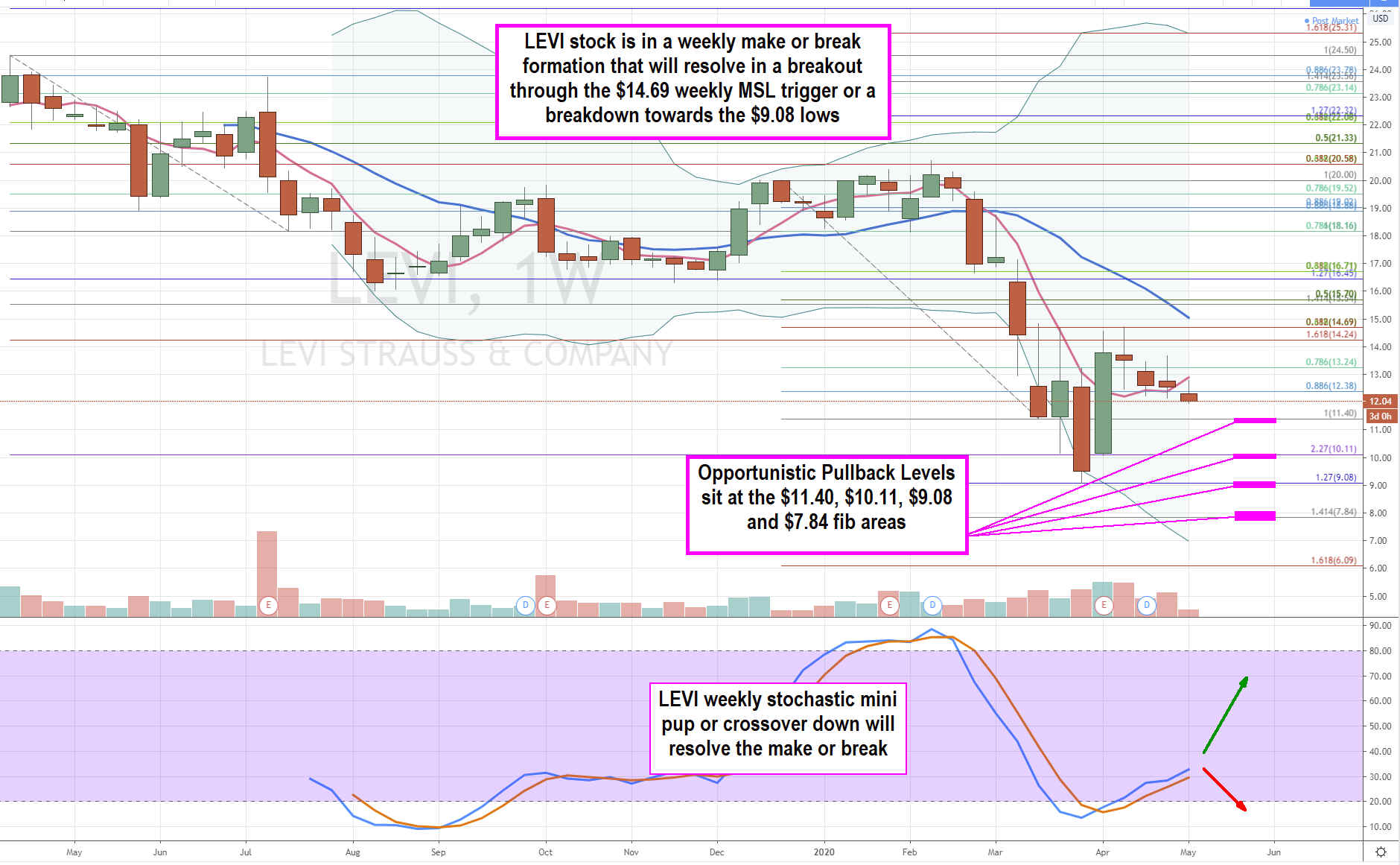Iconic clothing brand
Levi Strauss & Co. (NYSE: LEVI) has been in operations for 167 years going public in February 2019. The company survived through global pandemics, world wars and stock market crashes to flourish through the ages with its timeless denim jeans sold worldwide in over 110 countries. The brand and company has stood the test of time as an embodiment of stability. The COVID-19 pandemic triggered systemic risk fears that transpired into a (-35%) plunge in the
S&P 500 (NYSEARCA: SPY) at its lows in late March 2020. A “throw the baby out with the bathwater” panic ensued causing destruction for many but opportunities for astute investors seeking solid long-term value plays. Opportunistic entries may once again present themselves at cheaper levels than the 12.5X price-earnings (P/E) LEVI trades at.
Q1 2020 Earnings Results
On April 7, 2020, LEVI reported their fiscal Q1 2020 earnings results for the quarter ended Feb. 23, 2020. Non-GAAP EPS was $0.40, beating consensus analyst estimates by $0.05. Top line revenue growth was up 5% year-over-year (YoY) to $1.51 billion versus the $1.46 billion analyst estimates. The company
LEVI president and CEO Chip Burgh stated on the conference call, “I believe we are well-positioned, if not better positioned than most companies in our industry”. The company pulled it guidance due to the uncertainty stemming from the disruption from COVID-19. He noted the company cash position is strong enough to weather the next 12-months with $820 million cash on hand and total available liquidity of $1.8 billion. Burgh further stated, “Our business was humming coming in through the crisis, again reaffirming the robust strategies that we are executing… I’m confident that we will emerge strong on the other side.”
Impacts of COVID-19
The company reported the company’s China stores closed in mid-January amidst double-digit revenue growth with all company and franchise locations closed in China. However, all China-based store locations with the exception of six franchises reopened in April as the COVID-19 spread passes, and consumers resume normal activity. As of mid-March, stores outside of China have all been temporarily closed in response to the pandemic. The company expects a significant impact in Q2 2020 earnings as a result of isolation mandates. Digital commerce continues to grow YoY. LEVI has solid liquidity generating $198 million in cash during Q1 2020 with net debt at $56 million for a leverage ratio of 1.4 at the end of Q1 2020. The company deployed $56 million of its $100 share buyback authorization to offset its 2020 employee stock grant dilution estimate and suspended further buybacks during this crisis.
Shaping the Restart Narrative
Markets are shifting from the stockpiling theme to the economic restart narrative as more jurisdictions and states ease up isolation mandates. The reopening of businesses and activities will continue to accelerate in phases as regions get back to “normal”. LEVI has a heads up on managing the re-openings and restarts due to its stores in China. LEVI has a valid template with China as the pandemic passes throughout each region. At $12, LEVI trades at just a P/E of 12.5. Granted, the E portion of P/E is the unknown moving forward. Therefore, patiently waiting for deeper pullbacks can help buffer the valuation offsets.

Opportunistic Entry Levels
Using the rifle charts on a weekly time frame provides a broader view of the landscape for LEVI stock. The weekly market structure low (MSL) buy trigger sit above the $14.70 Fibonacci (fib) level. However, it hasn’t triggered since a make or break formation is in progress. This will either result in a bullish stochastic mini pup if the 5-period moving average (MA) crosses up through the 15-period MA above the MSL. If the stochastic crosses down, then a bearish inverse pup breakdown will form causing shares to potentially test the $10.11 and $9.08 fib lows. The opportunistic pullback entry levels are at the $11.40 fib, $10.11 fib, $9.08 fib and $7.84 fib. Traders can use these fib levels to scalp reversions utilizing intraday time frames. Swing traders can scale for overnight to multi-day holds on converging daily/60-minute stochastic. Longer-term investors may consider a pyramid sizing dollar-cost averaging approach with a covered call strategy to buffer downdrafts.
Before you make your next trade, you'll want to hear this.
MarketBeat keeps track of Wall Street's top-rated and best performing research analysts and the stocks they recommend to their clients on a daily basis.
Our team has identified the five stocks that top analysts are quietly whispering to their clients to buy now before the broader market catches on... and none of the big name stocks were on the list.
They believe these five stocks are the five best companies for investors to buy now...
See The Five Stocks Here
Wondering where to start (or end) with AI stocks? These 10 simple stocks can help investors build long-term wealth as artificial intelligence continues to grow into the future.
Get This Free Report
Like this article? Share it with a colleague.
Link copied to clipboard.